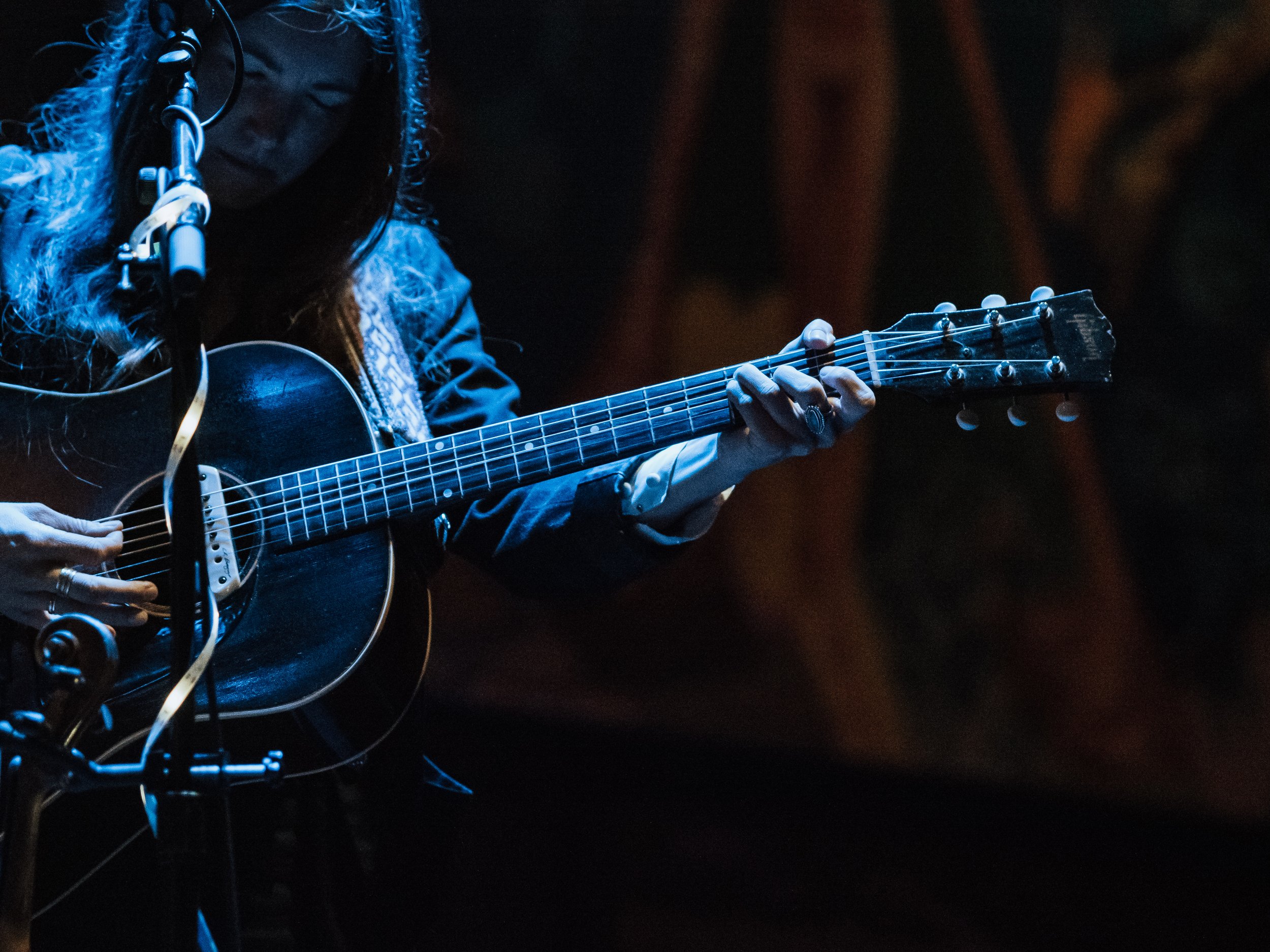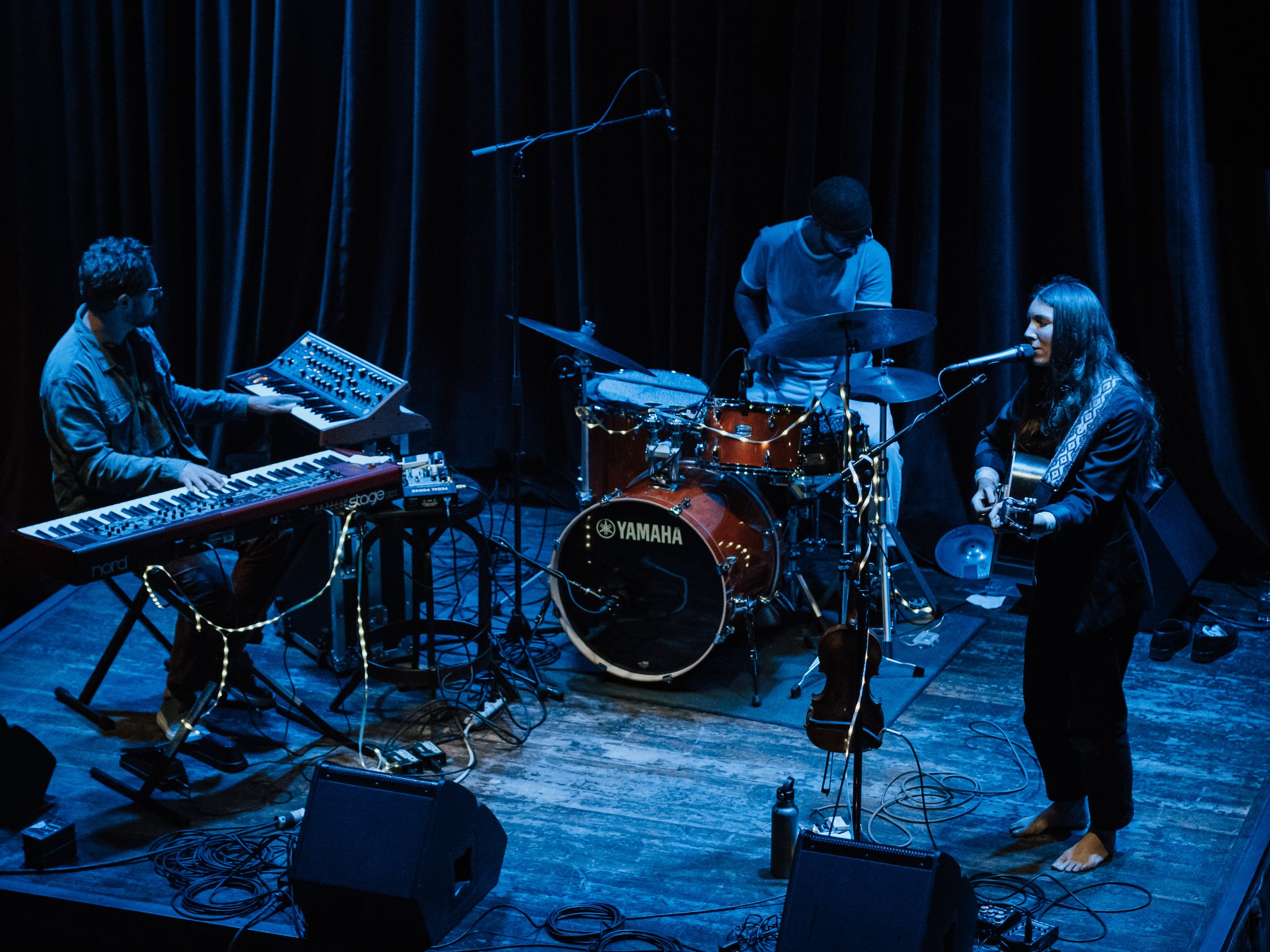Anna Tivel has always had a strange relationship with clothing. From one side you hear the depth and detail in her music, which visually can be an explosion of color and expression. While on the other side, she’s has always been in a state of trying to be invisible. Growing up in rural central Washington, she remembers the hometown style of being a non-style. People focused more on the functionality then approaching clothing as an expression. There is a lot of farming culture where clothing is made to work in and made to be rained on. This past has led to a skepticism of fashion and not really seeing style as an important thing.
Her first memories of engaging with clothing started by going into thrift stores and seeing all the fabrics and colors. She would get sweatshirts at Value Village, find colorful socks, and then cutting them into letters and shapes, sewing them onto the sweatshirts or even ears onto the hoods. She remembers being very excited about making things unique, like a piece of art. At the same time, there’s been an ingrained tradition for invisibility which has lead to phases of wearing all black and not wanting it to be anything at all.
“Maybe because I grew up this way, it was really not okay to draw attention to yourself. I think probably a lot of it comes from that zone of you shouldn’t be showing off your legs. A lot of my things are informed by wanting to steer away from that being part of what people are seeing in me or my aesthetic shouldn’t be related to body parts. I’ve noticed that sometimes I’ll put on a tight dress and just feel so not right. I have fun at home, but as soon as I feel observed, I don’t like being seen that way,” Anna confesses.
At the age of 18, Anna moved to Portland and immediately experienced an expansion of the thrift shop culture. Stores were filled full with rainbow fur and fun fabric to touch and explore. The move to Portland was an immediate witnessing of personal articulations and happiness with fashion. The feeling of being in a big city, having unlimited resources, and sharing in that culture helped her further develop that internal sense of identity. It was then that she also developed an interest in songwriting, writing and performing her own material.
“It just felt really good to be somewhere where people are doing a lot of different things with their minds and also with their clothes and their arts.”
-Anna Tivel
Hit play on any of Anna’s albums and you’ll come face to face with an intimate and intricate style of narrative. Her songs play like cross-stitched stories, each lyric and line another detail in the loom. These observations executed as sung poetry distinctly places Anna as one of the finest storytellers of modern folk. Her release The Question was hailed as “one of the most ambitious folk records of 2019.” The latest release continues that enthusiasm with Outsiders. The opening lines placing us miles above as a lonely astronaut looks down for the very first time at Earth, finding a shared humanity in what they see.
“Imagine the very first man on the moon, watching the earth rising up
Out of the darkness cerulean blue, water and thunder and dust
Floating like magic alive in the air, his body a weightless machine
Farther away than a plane or a bird or a dreamer had ever been”
Hearing her trio perform the new album on the three-sided stage at Icehouse, the details strut forward. The soft heartbeat mallets on “Ruins”, or the sway of her voice on “Astrovan”, or even the fluttering electronics of the keyboards on “Royal Blue”, were joyous journeys behind the eyes of Anna. Her naked feet connected to wood, the lights fixed in place, and the tiny string lights adorned on the instruments providing a proverbial line connecting the band together. Camouflaged into the music, Anna performs with intention to deliver and allow the words and notes to breath. It’s as much of a viewing event as a listening event.
During the pandemic, Anna started sewing again and has made a lot of her own clothes. She uses the thrift stores as a place to wander in her mind, look through things, trying on fun things, and seeing what people are getting rid of.
She’ll hunt for sheets, curtains, and tablecloths to make into suits and shirts. The approach is artful and creative, while being a bit weird and fun while making it her own. She’s not trying to be pretty but wants to express something in these pre-owned pieces.
The feeling that comes from taking something that was somebodies’ old tablecloth, making it unto a suit, makes it feel found again. This adds to the story and imagination of the clothing, continuing that journey forward.
“I love story maybe as a way to feel your way around ideas and things that you see and hear and experience. It’s helpful to me to take things in a swirly, colorful narrative versus facts. To hear things in a story form means a lot to me. I think we're all just like that. We love just narrative.”
Her black loafers came from a thrift store in Georgia. The black coat also from a thrift store, but Anna took off the buttons, adding her own. The new brass buttons look like tiny family crests down the side. The white shirt has a disguised pattern that only reveals itself when to get close enough.
The large oval ring on her left hand was a gift from her boyfriend, found while he was leaning down to pick up a dog turd. It’s a little broken, but Anna still wears it everyday.
The left hand holds a ring that was her mothers’ mom’s wedding ring to her first husband that died in WWII.
Her style is drawn to simple expressions of intrigue or mystery, referencing Leonard Cohen as a classic example. She smiles,
“He was such a classy guy. He looks like a mind. He just looks like there’s things in his mind that are happening. And even his clothes are intentional it feels like.”
Anna is quick to disclose the importance of having people hear the music before they see her clothes. Part of that is wanting people to take her words seriously, to witness the writing and words first. She’s also found in the past that if she doesn’t feel like she’s delivering the words as unadorned as possible, if there’s a colorful shirt or short skit, that people will be distracted. It hearkens back to that discomfort of being seen for the wrong reasons, especially when you’re a serious writer that puts as much visual detail into songs as she does. That process is clearly observed when seeing her perform. The first 3-4 songs are a straight focused on the music, easing the picture wider and wider until she breaks the 4th wall and engages with the audience.
Anna’s vision when attending a show is for people to feel taken care of and swept up on a journey. The hope that they can relax and trust that it appears the way it should, where they can just lean into it and feel the music. She wants to take away any battles with that and make it easy for them to absorb and hear the stories within the song.
She admits that there’s a constant journey internally happening for her on figuring out the visual side, especially when you don’t love to be observed. That resolve is slowly coming as Anna concedes that style and fashion can be part of the art and a form of deep expression.
Check out the links below for ways to follow Anna Tivel and all the things we mentioned above.
Anna Tivel Website - Instagram - Facebook - Merch - NPR Review - Value Village






















